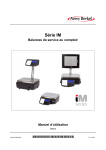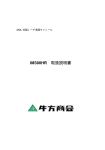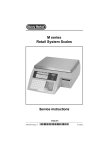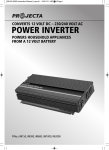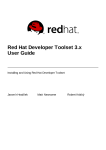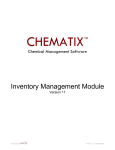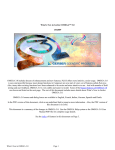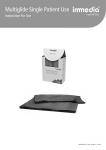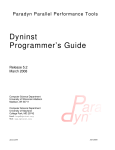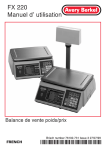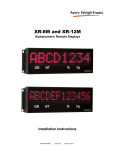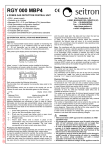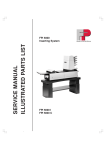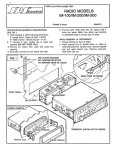Download user manual
Transcript
IM Series Counter Service Scales Service Instructions ENGLISH AWT35-000324-AA *AWT35-000324* 17-09-2007 ©Avery Berkel, 2007. All rights reserved. The information contained herein is the property of AveryBerkel (a division of ITW Ltd) and is supplied without liability for errors or omissions. No part may be reproduced or used except as authorized by contract or other written permission. The copyright and the foregoing restriction on reproduction and use extend to all media in which the information may be embodied. Trademarks and acknowledgements Avery Berkel is a registered trademark in certain jurisdictions. All brands and product names used within this document are trademarks or registered trademarks of their respective holders. IMPORTANT When programming or configuring the equipment you must ensure that you comply with all relevant standards and legislation. The example settings given in this book may not be legal for trade with the public. Contents page no. 1 Safety and Warnings 5 1.1 Warnings 6 2 Installation 9 2.1 Installation 10 2.2 Cable management 11 2.3 Self service keyboards (IM300) 12 3 Displays and keys 13 3.1 Display 14 3.2 Keyboard overlay 15 4 Service mode 17 4.1 Service mode overview 18 4.2 Enter/Exit service mode 19 4.3 Navigating service mode menus 21 4.4 Diagnostics 22 4.5 Configuration 24 4.6 Calibration 31 4.7 Site gravity 32 4.8 Service PIN 33 4.9 Alternative currency setup 34 4.10 Clone machine 36 4.11 Data clone 37 4.12 Label editor menu 38 4.13 Service setup 43 4.14 Diagnostic logs 49 5 Service procedures 51 5.1 Power up/power down 52 5.2 Calibration 52 5.3 Firmware update 53 5.4 Weighplate, cross and top cover 54 5.5 Customer display assemblies 56 5.6 Front module/vendor displays 59 5.7 Column mounting 63 5.8 Main board 65 5.9 Loadcell 66 IM series Service Instructions 3 4 5.10 Printer 67 6 Exploded views 69 6.1 IM100 models 70 6.2 IM202 models 71 6.3 IM300 models 73 6.4 IM400 models 74 7 Schematics and wiring 77 7.1 External connections 78 7.2 Internal connections 80 8 Module information 85 8.1 Main board 86 8.2 Display PCB 88 9 Networking 91 9.1 Typical networks 92 9.2 Network protocol 94 9.3 Wiring/terminations 94 9.4 Network setup 95 9.5 Network map 99 9.6 Backup server operation 100 9.7 Local mode 101 IM series Service Instructions Safety and Warnings 1 This chapter contains information about possible hazards and precautions you should take. Contents 1.1 - Warnings (page 6) IM series Service Instructions 5 1.1 Warnings Safety and Warnings 1.1 Warnings 1.1.1 Installation and service THE EQUIPMENT CONTAINS NO USER SERVICEABLE COMPONENTS. Installation and maintenance of the equipment must only be carried out by trained and authorised personnel. 1.1.2 Electrical installation The mains lead must be connected to a supply outlet with a protective earth contact. The electrical supply at the socket outlet must provide over current protection of an appropriate rating. Pluggable equipment must be installed near an easily accessible socket outlet. Permanently connected equipment must have a readily accessible disconnect device incorporated in the fixed wiring. USA If the scale is connected to a 240V supply, the receptacle must be protected by a 15 amp circuit breaker. 1.1.3 Risk of electric shock To avoid the possibility of electric shock or damage to the machine, always switch off the machine and isolate from the power supply before carrying out any routine maintenance. Always completely isolate from the power supply before: O removing the machine cover(s) O performing any routine maintenance O cleaning the machine. 1.1.4 Safe handling To avoid the risk of the machine falling, where applicable, ensure that it is placed securely on a flat and level surface. When lifting, moving or supporting the machine, take its weight into consideration. 1.1.5 O O O 6 Additional service precautions When the covers are removed, do not apply power to the unit unless specifically instructed to do in this handbook. When working on live equipment, exercise great care, use insulated tools and test equipment, and do not work alone. When testing or fault finding, exercise extreme care. Ensure that any test equipment used is in good condition and capable of withstanding the existing voltages. IM series Service Instructions 1.1 Warnings O Safety and Warnings All tools used must have insulated handgrips. Test probes and jumper leads must be in good condition with adequate insulation. Test probes with claw ends and jumper leads must not have insecure parts that may fail during use. 1.1.6 Replacing batteries CAUTION: Risk of explosion if battery is replaced by an incorrect type. Dispose of used batteries according to instructions. 1.1.7 Cleaning the machine CAUTION: Harsh abrasives, solvents, scouring cleaners and alkaline cleaning solutions, such as washing soda, should not be used especially on the display windows. Under no circumstances should you attempt to wipe the inside of the machine. The outside of standard products may be wiped down with a clean cloth moistened with water containing a small amount of washing up liquid. The outside of products waterproofed to IP65, IP66 and IP67 may be washed down with water containing a small amount of a proprietary detergent. Cleaning the print head CAUTION: Do not use metallic objects on the print head. Only use the recommended print head cleaning kit. 1.1.8 Training To avoid the risk of RSI (Repetitive Strain Injury) it is important to ensure that the machine is placed on a surface which is ergonomically satisfactory to the user. It is recommended that frequent breaks are taken during prolonged usage. 1.1.9 EMC compliance The following warning may be applicable to your machine. WARNING: This is a class A product. In a domestic environment this product may cause radio interference in which case the user may be required to take adequate measures. IM series Service Instructions 7 Safety and Warnings 8 1.1 Warnings IM series Service Instructions Installation 2 IM300 and IM500 models have additional installation instructions. You should read the relevant instructions before installing those models. CAUTION: IM300 and IM500 models should not be installed by one person alone. Contents 2.1 - Installation (page 10) 2.2 - Cable management (page 11) 2.3 - Self service keyboards (IM300) (page 12) IM series Service Instructions 9 2.1 Installation Installation 2.1 Installation 2.1.1 Check list Kit List Scale Power supply Documentation CD Quick User Guide Self service keyboard (IM300 only) Installation Instructions (IM300 and IM500 only) 2.1.2 Location Make sure that the work surface or counter is: O strong enough to support the weight of the scale O stable, steady and free from draughts and vibrations. 2.1.3 Handling Mis-handling of the scale can affect the scale’s ability to weigh accurately. 2.1.4 10 Levelling IM series Service Instructions 2.2 Cable management 2.2 Installation Cable management Cable clamps Figure 2.1 External cable routes IM series Service Instructions 11 Installation 2.3 2.3 Self service keyboards (IM300) Self service keyboards (IM300) Single and twin keyboard models The self service keyboard is supplied as a separate item. It must be connected before the scale will operate. Follow the installation instructions (part number AWT35-000308) supplied with the IM300 kit. CAUTION: Do not attempt to fix the self service keyboards by yourself. Get assistance from a second person. Note: After installation you may need to configure the keyboard from within Manager Mode. Refer to the User Instructions for further information. 12 IM series Service Instructions Displays and keys 3 This chapter describes the keyboard and basic key functions. Contents 3.1 - Display (page 14) 3.2 - Keyboard overlay (page 15) IM series Service Instructions 13 3.1 Display Displays and keys 3.1 Display 6 1 2 5 3 4 Figure 3.1 Typical weighing display 1. Metrological information 2. Price per unit 3. Price of goods 4. Product description (PLU text) 5. Weight information (net/tare weight) 6. Model number 14 IM series Service Instructions 3.2 Keyboard overlay Keyboard overlay À A g Ä G Æ H N M N ? S Ø Caps Lock Ó * Ü : Ú Z Space ( XXX £ $ F / # L K Ô ! R P U € E ° J T Shift ALT 3.2.1 Ö É D Í O Z Y D I N S Š Ç C % G & Figure 3.2 C B @ Q + V ) R R - = W X . ; 0 7 8 9 4 5 6 1 2 3 0 “ , = Á Å , 3.2 Displays and keys Enter Cntrl IM202 programming overlay Keys Reset the weight display to zero Subtracts the weight of the container when weighing goods. In receipt mode, retains the PLU until the transaction is entered. Retains a tare, if in operation, until it is cancelled. In label mode, the PLU is retained until it is cancelled. Sets the scale to pre-pack if the machine configuration allows it. Cancels a PLU or hand entered price. Depending on the function in use, clears messages or characters from the display. Totalises transaction. In receipt mode, when the subtotal is displayed, prints a receipt. In label mode, prints a label. IM series Service Instructions 15 Displays and keys 3.2 Keyboard overlay Confirms data entry. Enables you to change the number of items when serving non-weighed items. Override the programmed price of a PLU. Cancels an unwanted transaction from an operator subtotal. In label mode, when set to print totals labels only for ADD key transactions, it cancels an unwanted transaction from the subtotal. Depending on machine configuration, allows totals labels or totals and individual labels to be printed. Initiates a display test sequence. Pressed again during the test sequence prints a test report. Press operator key and type in PIN during test sequence to gain access to Manager Mode. Double zero key. Move to the item above in the displayed list Move to the item below in the displayed list 16 IM series Service Instructions Service mode 4 CAUTION: When programming the scale you must ensure that you comply with all relevant standards. The example settings given in this book may not be legal for trade. Contents 4.1 - Service mode overview (page 18) 4.2 - Enter/Exit service mode (page 19) 4.3 - Navigating service mode menus (page 21) 4.4 - Diagnostics (page 22) 4.5 - Configuration (page 24) 4.6 - Calibration (page 31) 4.7 - Site gravity (page 32) 4.8 - Service PIN (page 33) 4.9 - Alternative currency setup (page 34) 4.10 - Clone machine (page 36) 4.11 - Data clone (page 37) 4.12 - Label editor menu (page 38) 4.13 - Service setup (page 43) 4.14 - Diagnostic logs (page 49) IM series Service Instructions 17 4.1 Service mode overview Service mode 4.1 Service mode overview Setting the scale into service mode allows you to configure many aspects of the scales functionality. Service Mode Diagnostics Configuration Country Config. Calibration Site Gravity Service PIN Alt. Cncy. Setup Diagnostics Weighing Test Keyboard Test Network Test Calibration USB Test Printhead Life Dynamic RAM Test Static RAM Test Service PIN Label Editor Edit Format Label Editor Restore Format Bank 1 Bank 3 Bank 2 Currency Symbol Service Setup Diagnostic Logs Country Config Alt. Cncy. Setup Currency Rate Copy Format Data Clone Configuration Site Gravity Data Clone Clone Machine Bank 4 Clone Machine Euro Wizard Service Setup List Format Printer Setup Initialise Machine Currency Text Serial Number Config Wizard Model Number Diagnostic Logs Print Logs Figure 4.1 18 Set Log Size Clear All Logs Service mode menu structure IM series Service Instructions 4.2 Enter/Exit service mode 4.2 Service mode Enter/Exit service mode There are two levels of service mode available. O Full service access Full access to all service options including calibration. O Restricted service access Limited access to certain service options. Calibration is not available. Note: For all service options, you will need the programming overlay on the keyboard. 4.2.1 Full service access Full service mode allows unrestricted access to the service mode configuration menus. To enter full service mode: 1. Switch on the scale. 2. On the underside of the scale, locate the access hole for the service switch. 3. Carefully insert a narrow bladed screwdriver until it just touches the service switch Service switch access Figure 4.2 Location of service switch access hole. IM series Service Instructions 19 4.2 Enter/Exit service mode Service mode 4.2.2 Restricted service access Restricted access limits the changes you can make to the scale. Restricted access excludes the following: 1. Changing the capacity 2. Changing the gravity zone compensation 3. Calibrating the scale. To enter restricted service mode: 1. Switch off the scale and then switch it on again. 2. During the display countdown, enter the service PIN. (Default PIN is 9467.) Note: To change the service PIN see Service PIN on page 33 4.2.3 Exit service mode To return to manager or sales mode 20 Press to return to manager mode. Press twice to return to sales mode. IM series Service Instructions 4.3 Navigating service mode menus 4.3 Service mode Navigating service mode menus Use the following keys to navigate the menus: Enter Select the item Enter a value or Back Move up one menu level Previous Select previous item Next Select next item Quick save Save data entered up to this point Home/Exit Return to manager mode Exit service mode Numeric keypad Select numbered menu item IM series Service Instructions 21 4.4 Diagnostics Service mode 4.4 Diagnostics Diagnostics Weighing Test Figure 4.3 Keyboard Test Network Test USB Test Printhead Life Dynamic RAM Static RAM Test Test Flash Test Diagnostics menu The diagnostics menu allows you to perform a number of tests. 4.4.1 Weighing test Displayed weight Sub-divisions Actual weight (number of divisions) 4.4.2 Keyboard test Select keyboard size 65 - Standard. 84 - Large TK keyboard 1 TK keyboard 2 O O 22 Press each key on the keyboard in turn starting from the top left and working towards the right for each row of keys. Press the same key three times to exit test. IM series Service Instructions 4.4 Diagnostics 4.4.3 Service mode Network test This tests that the scale’s network is working correctly. The scale will talk to another device on the network over a number of cycles. A successful test indicates that the network configuration is working correctly. 4.4.4 USB test This hardware test checks that the USB port is working correctly. 4.4.5 Printhead life This is for factory testing purposes only. 4.4.6 Dynamic and static RAM, and Flash test Checks that the memory is functioning correctly. IM series Service Instructions 23 4.5 Configuration Service mode 4.5 Configuration The configuration tables determine many of the scale’s operating parameters. Configuration Bank 1 Figure 4.4 Bank 2 Configuration display Software version 7.0 Bank 1 Digit 1 Capacity (Not available in restricted access mode) 0 1 2 3 4 5 6 7 Not used Not used 30lb x 0.01 50lb x 0.01 6kg x 1g Not used 6kg AVR Not used 8 15kg x 5g 9 15kg AVR A Not used B 30kg x5g C Not used D 30lb/15kg E - T Not used 2 Tare system 0 Free 1 Free, Graduated 2 Free, Cumulative, Graduated 3 Free, Cumulative, Graduated, Proportional 3 Tare display 0 No tare display 1 Negative weight display 4 5 2 10 divisions 3 20 divisions Bleep behind zero, over range and balance lost 0 Disabled 6 1 Enabled Numeric entry timeout 0 Disabled 24 2 Separate tare display only 3 Separate tare and negative weight Minimum weight disturbance 0 1 division 1 4 divisions 7 4 Free, Stored 5 Free, Graduated, Stored 6 Free, Cumulative, Graduated, Stored 7 Free, Cumulative, Graduated, Proportional, Stored 1 Enabled PLU auto recall timeout IM series Service Instructions 4.5 Configuration Service mode Bank 1 0 1 2 3 4 None 0.6 seconds 1.0 seconds 0.3 seconds 0.4 seconds 5 6 7 8 9 8 0.5 seconds. 2.0 seconds 3.0 seconds 4.0 seconds 5.0 seconds Receipt tax printing 0 None 1 Totals tax 2 Itemised tax 9 Weight filter type 0 1 2 3 Settling time 0.2s (71.2Hz) Settling time 0.5s (71.2Hz) Settling time 1.0s (71.2Hz) Settling time 1.9s (71.2Hz) 4 5 6 7 10 Settling time 0.2s (81.2Hz) Settling time 0.5s (81.2Hz) Settling time1.0s (81.2Hz) Settling time1.9s (81.2Hz) Price base 0 Single price base (lb/kg) 1 Single price base (1/4lb/100g) 11 2 Dual price base (lb/kg) 3 Dual price base (1/4lb/100g) Printer type 0 None 1 Receipt only 2 Label only 3 Label and Receipt 12 Default sales mode and machine type 0 Hand price mode, weighing 1 PLU price mode, weighing 13 2 Hand price mode, non-weighing 3 PLU price mode, non-weighing Add function 0 None 1 Transaction + total 2 Total only 14 3 Receipt only 4 Transaction and receipt Date type 0 Numeric 15 1 Alpha Date format 0 DD MM YY 1 MM DD YY 2 YY MM DD 16 3 DD MM YYYY 4 MM DD YYYY 5 YYYY MM DD Maximum transaction sequence number 0 999999 1 99999 2 9999 IM series Service Instructions 3 999 4 99 5 9 25 4.5 Configuration Service mode Bank 2 Digit 1 Dummy zero in unit price) 0 6 digit UP, 6 digit TP, no dummy zero 1 6 digit UP, 6 digit TP, dummy zero 2 Transaction rounding 0 Round to nearest 1 1 Round to nearest 5 2 Round to nearest 10 3 3 3 decimal places 4 0 on unit price, 1 on total price 5 Thousands separators 4 Punctuation 0 Decimal point 1 Comma 2 Inverted comma 5&6 Currency symbol 00. 01. 02. 03. 04. 05. 06. 07. 08. 09. 10. 11. 12. 13. 14. User defined £ $ R F (French) Kr DM S Fr f Lit P E K M 7 15. D 16. RM 17. L 18. N$ 19. Esc 20. Pta 21. Rp 22. mk 23. PX 24. SR 25. zt 26. Kc 27. SK 28. kr 29. DHS 30. Won 31. bt 32. Pts 33. EEK 34. Lt 35. € 36. Eur 37. R$ 38. B 39. C 40. Q 41. TL 42. F (Belgian) 43. BD 44. LE 45. JD 46. KD 47. LL 48. RO 49. QR 50. SR 51. YR 52. Ft 53. kn 54. Lm 55. Ksh 56. RON 57. ROL 58. LEI PLU auto recall timeout 0 1 2 3 4 None 0.6 seconds 1.0 seconds 0.3 seconds 0.4 seconds 8 5 6 7 8 9 0.5 seconds. 2.0 seconds 3.0 seconds 4.0 seconds 5.0 seconds Receipt tax printing 0 None 1 Totals tax 26 3 Round to nearest 25 4 Round to nearest 50 Number of decimal places 0 No decimal places 1 1 decimal place 2 2 decimal places 9 2 5 digit UP, 6 digit TP, no dummy zero 3 7 digit UP, 7 digit TP, no dummy zero 2 Itemised tax Weight filter type IM series Service Instructions 4.5 Configuration Service mode Bank 2 0 1 2 3 Settling time 0.2s (71.2Hz) Settling time 0.5s (71.2Hz) Settling time 1.0s (71.2Hz) Settling time 1.9s (71.2Hz) 4 5 6 7 10 Settling time 0.2s (81.2Hz) Settling time 0.5s (81.2Hz) Settling time1.0s (81.2Hz) Settling time1.9s (81.2Hz) Price base 0 Single price base (lb/kg) 1 Single price base (1/4lb/100g) 2 Dual price base (lb/kg) 3 Dual price base (1/4lb/100g) 11 Printer type 0 None 1 Receipt only 2 Label only 3 Label and Receipt 12 Default sales mode and machine type 0 Hand price mode, weighing 1 PLU price mode, weighing 2 Hand price mode, non-weighing 3 PLU price mode, non-weighing 13 Add function 0 None 1 Transaction + total 2 Total only 3 Receipt only 4 Transaction and receipt 14 Date type 0 Numeric 1 Alpha 15 Date format 0 DD MM YY 1 MM DD YY 2 YY MM DD 16 3 DD MM YYYY 4 MM DD YYYY 5 YYYY MM DD Maximum transaction sequence number 0 999999 1 99999 2 9999 3 999 4 99 5 9 Country configuration Country config. Bank 3 Bank 4 Bank 3 Digit 1 Balance key range 0 ± 2% 2 1 ± 5% +15% -5% Balance at power up 0 Disabled 3 1 Enabled Large step behind zero 0 Disabled IM series Service Instructions 1 Enabled 27 4.5 Configuration Service mode Bank 3 4 Reduced zero tracking 0 Disabled 5 Retained tare mode 0 Disabled 6 1 Enabled Manual tare calculation 0 None 1 tare key 7 2 Zero key 3 Tare and zero key Price interlock/NTEP operation 0 Disabled 1 Price and tare 8 2 NTEP operation. Fix tare options 0 Fix tare and unit price 9 1 Fix tare only Open cash drawer with zero total 0 Disabled 10 1 Enabled Price 1/price 2 swap positions on label 0 Disabled 11 1 Enabled Receipt total currency symbols 0 Disabled 12 1 Enabled Minimum prepack weight 0 1 division 13 1 20 divisions Prepack allows stored/grad tares 0 Disabled 14 1 Enabled Triple zero key 0 Disabled 15 1 Enabled Tax system 0 Inclusive 1 Exclusive 16 2 Inclusive, PoS only 3 Exclusive, PoS only Tax reference in description 0 Disabled 28 1 Enabled 1 Enabled IM series Service Instructions 4.5 Configuration Service mode Bank 4 Digit 1&2 Language 00 01 02 03 04 05 06 07 08 09 10 11 12 13 English (UK) Spanish RSA French German Italian Dutch Danish Polish Czech Portuguese Finnish Norwegian Turkish 14 15 16 17 18 19 20 21 22 23 24 25 3 Greek Croatia Hungary Sweden Arabic English (US) Romanian Estonian Bulgarian Russian Ukrainian English (Arabic) Sales key layout 0 IM All markets Price Base 4 Manager key layout 0 IM European 1 IM Greek 5 2 IM Arabic 3 IM Cyrillic Receipt algorithms - transaction count on receipt / display per transaction assigned 0 1 2 3 4 Algorithm A B C D E 6 Weighed 1/1 1/1 1/1 1/1 1/1 n/1 1/1 n/1 1/1 n/1 n x (+ve non-weighed) 0/1 1/1 0/1 n/1 0/0 n x (-ve non-weighed) Receipt formats 0 Receipt format 0 - Italian format which includes tare weight 1 Receipt format 1 - No symbols line, symbols printed with transaction data. First line contains text and total price. Second line contains weight/multiplier and unit / item price. 2 Receipt format 2 - As receipt format 1 except total price printed on third line for weighed. 3 Receipt format 3 - Symbols line. First line contains text. Second line contains weight/multiplier, unit / item price and total price. 4 Receipt format 4 - Each transaction contains its own symbols line. 5 Receipt format 5 - USA receipt format. Identical to format 1 except that 'X' and 'Items' is replaced by '@' 6 Receipt format 6 - Australian receipt format. Identical to format 5 except description not allowed to encroach on the total prices column. 7 Condensed format 0 Disabled 8 1 Enabled Change calculation 0 Disabled 9 1 Enabled Direct entry prepack 0 Disabled IM series Service Instructions 1 Enabled 29 4.5 Configuration Service mode Bank 4 10 Net weight 0 Grams 11 1 oz - lb/oz USA total price legend 0 Disabled 1 Using net weight (per 100g) 2 Using actual weight (Danish) 12 3 Using net weight (per kg) 4 By product type Back calculation of unit price 0 1 division 1 20 divisions 13 & 14 Country 00 01 02 03 04 05 06 07 08 09 10 11 12 13 14 15 16 17 18 19 20 15 UK Spain South Africa France Germany Italy Netherlands Denmark Poland Czech Republic Portugal Finland Norway Turkey Greece Croatia Hungary Sweden Saudi Arabia General Export Indonesia 21 22 23 24 25 26 27 28 29 30 31 32 33 34 35 36 37 38 39 40 41 Frequent shopper algorithm 0 Compute frequent shopper price from printed weight 1 Compute frequent shopper price from backcalculated weight 16 30 Australia New Zealand USA Ireland UAE Canada Malaysia Zimbabwe Lithuania Estonia Egypt Mexico Panama Belgium Switzerland Austria Tunisia Romania Bulgaria Russia Ukraine 2 Compute frequent shopper price from saving and back-calculated weight 3 Frequent shopper price scheme 3 Not used IM series Service Instructions 4.6 Calibration 4.6 Service mode Calibration 1 Ensure you are in full service mode - see page 19. 2 Select Calibration from the available options. 3 If the site and factory gravity factors differ, then you will be prompted to enter the factory gravity factor. Refer to the local authority for details. Use the left/right arrows to set the decimal point. 4 Calibrate with zero load. Ensure there is no weight on the scale, then press ENTER. 5 Calibrate with full load. Place a full load on the weighplate, then press ENTER. Note: the last 3 digits will be unstable. IM series Service Instructions 31 4.7 Site gravity Service mode 4.7 Site gravity If the scale has been moved to a different gravity zone, enter the site gravity compensation factor. Refer to the local authority for details. Note: This is the gravity factor for the location where the scale is to be used 32 IM series Service Instructions 4.8 Service PIN 4.8 Service mode Service PIN You can change the four digit restricted service access PIN from this menu. Only change the PIN if you think that the user knows the service PIN and is tampering with the machine's configuration. IM series Service Instructions 33 4.9 Alternative currency setup Service mode 4.9 Alternative currency setup 4.9.1 Currency rate and symbol The currency rate and symbol setup options are used to configure a second currency. 1 Ensure you are in full service mode - see page 19. 2 Select Alt. Cncy Setup from the available options. 3 Press to select Currency Rate. 4 Enter the required value for the currency. Note: Use the ‘Previous / Next’ arrows to position the decimal point. 5 Use the ‘Previous / Next’ arrows to select Euro Symbol. 6 Enter the value for the Currency Symbol. 35 = € (See configuration bank 2, digits 5 & 6 for details) 34 IM series Service Instructions 4.9 Alternative currency setup 4.9.2 Service mode Euro wizard This converts the PLU file from the local currency to Euro currency. The scale will then use the Euro as its primary currency. CAUTION: Only a factory reset can undo this operation. Euro rate and symbol procedure 1 Ensure you are in full service mode - see page 19. 2 Select Alt. Cncy Setup from the available options. 3 Use the ‘Previous / Next’ arrows to select Euro Wizard. 4 Set how the Euro will appear on the display / labels. Label 0 = 2nd price field shows alternative currency 1 = 2nd price field shows promotional value Barcode 0 = Barcode price printed as Euros 1 = Barcode prints alternate currency Label/ 0 = Euro symbol Display 1 = Euro text = 5 Select Yes to complete the process or No to abort. =Yes =No IM series Service Instructions 35 4.10 Clone machine Service mode 4.10 Clone machine This function allows you to update another machine on the network so that it is functionally identical to the one you are using. The clone function will copy the following information: O Executable files (application program) O PLU file O Label formats O Logos O Configuration and keyboard layouts Note: Machine specific information is excluded. (e.g. capacity, calibration data or gravity compensation factors) Network ID restrictions O O Application program - can be cloned irrespective of the network IDs of the two machines. Data - can be cloned only if both machines are using the same network ID Clone procedure 1 Ensure you are in full service mode - see page 19. 2 Select Clone Machine from the available options. 3 Enter the IP address of the target machine. 36 IM series Service Instructions 4.11 Data clone 4.11 Service mode Data clone Data clone allows you to transfer all the data in one machine to another machine (or machines) on the network. The data clone function will copy the following information: O PLU file O Label formats O Logos O Configuration and keyboard layouts Network ID restrictions O Data - can be cloned only if both machines are using the same network ID For more information see Scale groups (Network ID) on page 93. Clone procedure 1 Ensure you are in full service mode - see page 19. 2 Select Data Clone from the available options. 3 Enter the IP address of the target machine. IM series Service Instructions 37 4.12 Label editor menu Service mode 4.12 Label editor menu Label Editor Copy Format Edit Format Restore Format List Format The scale has 12 (0 - 11) standard label formats and four (12 - 15) nutritional label formats. This menu allows the label formats to be edited as required. Each label can have up to 26 fields on it. Note: The maximum printable area on a label is 160mm x 60mm. 4.12.1 Copy Format Copy format allows you to create an identical copy of an existing label format. The copy can then be modified using the Edit Format option (see below). 4.12.2 Edit Format This allows you to edit the label formats. At any time you may: O Use the ‘List Format’ function to print the current settings. O Use the ‘Test’ key to print a sample layout. Use the `List Format’ function to print the current settings. 1 Ensure you are in full service mode - see page 19. 2 Select Label Editor from the available options. 3 Select Edit Format from the available options. 4 Enter the number of the label format to be edited. (e.g. 5). 5 Use ‘Previous’ or ‘Next’ arrows to select the angle of rotation for the text & graphics on the label 38 IM series Service Instructions 4.12 Label editor menu Service mode 6 Enter the number of the field to be edited. (e.g. 8) 7 Use ‘Previous’ or ‘Next’ arrows to select the information that field is to display. (e.g Unit Price) 8 Use ‘Previous’ or ‘Next’ arrows to select the angle of rotation for the selected field 9 Enter the number (or letter) for the font to be used 10 Enter the X1 and Y1 distances in mm (See field positioning XX) (Use ‘Previous’ and ‘Next’ arrow keys to select between X1 & Y1) X1 = distance from left Y1 = distance from top IM series Service Instructions 39 4.12 Label editor menu Service mode 11 Enter the X2 and Y2 distances in mm (See????) (Use ‘Previous’ and ‘Next’ arrow keys to select between X2 & Y2) X2 = distance from right Y2 = distance from bottom To print a test label To save and exit To exit without saving To move to the next field Shift Typical test print Field area Field number Graphic Fld: 13 Ref. = 03 Fld:11 Fld:06 Fld:07 12 Fld:16 Fld:14 d:09 Barcode Fmt Std: 14 Fld:00 Fld:10 Field reference Fld:08 Fld:17 Fld:15 Store name USR - User defined field STD - Standard default label format Figure 4.5 40 Note: This field appears in this position on all labels Typical label format test print IM series Service Instructions 4.12 Label editor menu Service mode Field position notes The position of the fields on a label are set by a bounding box. This uses the distances X1, Y1, X2, Y2; illustrated as follows. X1 & Y1 View X2Y2 Label feed direction X1Y1 Field or X1Y1 Field X2Y2 View Label feed direction Field rotation 0° Field rotation 90° X2 & Y2 X2Y2 Label feed direction Field rotation 0° Field or Field X1Y1 X1Y1 View X2Y2 View Label feed direction Field rotation 90° Note: The distances are entered for the direction in which the label is being viewed. IM series Service Instructions 41 4.12 Label editor menu Service mode 4.12.3 Restore format This option allows you to restore the specified label format to its factory default. 4.12.4 List format This option will print out details about all the fields that are used on the specified label format *** Label Format List *** 01-11-2000 10.39 Field information 42 Usr Label Format Label Rotation 3 0B Field 00 PLU Text Font D Co-ords: 0.7.1550.5 0B Label number 49.3 48.8 IM series Service Instructions 4.13 Service setup 4.13 Service mode Service setup Service Setup Printer Setup Initialise Machine Currency Text Serial Number Config Wizard Model Number 4.13.1 Printer setup Do not adjust these settings unless there is a problem with the printer. Density This allows you to set the print density on the print out. 1 = light 9 = dark (default = 5). If the print quality is poor check that the print head is clean. Poor quality printing can be caused by using inferior quality paper. Note: For machines with two printers, set the print density for the receipt (second) printer using the Printer 2 menu option. Sensor distance This allows the parking position distance to be adjusted (mm). Default setting is 48.5mm Note: You will need to reset the opto sensor distancefollowing a Factory Reset or replacing the main board. Label threshold (10 - 250) Set the sensitivity of the label gap sensor. 10 = Very sensitive to gaps between labels. 250 = Not very sensitive to gaps between labels. Default value = 50 Paper threshold (10 - 250) Set the sensitivity of the paper sensor. 10 = Very sensitive to presence of paper. 250 = Not very sensitive to presence of paper. Default value = 100 IM series Service Instructions 43 4.13 Service setup Service mode 4.13.2 Initialise M/C This allows you to: O Restart the machine O Set up the memory allocations. The options are: Warm restart This is the equivalent of switching off the machine and then switching on. Cold Start This will restart the machine and clear all the battery-backed RAM. This will delete ALL records except: Service PIN Sub net mask Label formats and logos Gateway IP address Configuration banks Number of receipts and transactions Euro rate Print density IP address Distance from sensor Network ID Diagnostic log size Host port number LCD contrast Calibration and gravity factors Factory reset USE WITH CAUTION! This will restore the machine to its factory default settings. Factory reset will delete ALL records except for the MAC (Media Access Control) address, calibration constants, gravity factors and bank 1, digit 1 of the machine configuration. Note: You will need to reset the opto sensor distance after a factory reset. 44 IM series Service Instructions 4.13 Service setup Service mode Factory reset values IP Address Reset to 88.200.100.5 Network ID Reset to 0 Host port number Reset to 3001 Sub net mask Reset to 255.0.0.0 TCP/IP Gateway Address Reset to 0.0.0.0 (disabled) Logos All (user logos) deleted Label formats Reset to default settings Calibration Unchanged Gravity Unchanged Configuration banks Reset to default settings except for digit 1 bank 1 Alt. Cncy. conversion rate Reset to 1.00 Print density Reset to 5 Number of receipts and trans. Reset to 20 receipts and 8 transactions Distance from sensor to printhead Reset to 48.5mm LCD contrast Reset, but no change until machine is switched off and on. Service PIN Reset to 9467 Diagnostic log size Reset to small Audit mode Enabled Distance printed (mm) Reset to zero Delete PLU file This option deletes all the PLUs stored in the PLU file. Set Trans Memory This allows you to set the amount of memory allocated for transactions and receipts. Memory setting guidelines Note: Changing memory settings will induce a cold start and should therefore be done before other (customer) data is set. Each machine will store transactions according to the ‘Set Trans Memory’ option (selected from within the ‘Initialise M/C menu). You can set the following: O Num Receipts (Default = 20) The max number of receipts stored. O Num Trans / Recpt (Default = 8, Max = 99) The max number of individual transactions stored for each receipt. IM series Service Instructions 45 4.13 Service setup Service mode Audit settings The Trans memory required is closely associated with the Audit settings defined within manager mode. See the separate user instructions for more information. Trans memory - Client machines The memory allocated should reflect the requirements of the installation. Example:1 - Label Example scale requirements: 50 labels per hour (1 transaction per label 8 hours trading required in local mode (network fail) Memory requirements would be Num Receipts = 400 Num Trans per receipt = 2 Example:2 - Receipt Example scale requirements: 20 receipts per hour Average of 4 transactions per receipt 8 hours trading required in local mode (network fail) Memory requirements would be: Num Receipts = 160 Num Trans per receipt = 4 Trans memory - Server machines Settings notes - single servers For a server, receipts are only stored when live (prior to being totalised). Consequently, the maximum number of receipts stored will be the same as the number of operators using the system at any one time. Example:server requirements: 10 operators on system Up to 100 live transactions at any one time (assume equal split between operators) Memory requirements would be: Num Receipts = 10 Num Trans per receipt = 10 This would also limit the largest receipt, on the system, to 100 transactions (i.e. 10 x 10). Note: If an audit trail is required, the number of receipts and transaction stores should be set according to the length of trail required 46 IM series Service Instructions 4.13 Service setup Service mode Settings notes - dual servers Linear / Circular Buffer The server buffer can be set to either linear or circular. Manager Mode Audit Server buff mode Set to linear - If totals and/or audit trail integrity is vital. The number of receipt stores and transaction stores will determine how long trading can continue before an audit full condition is reached. Set to circular - If the ability to continue trading is more important. The number of receipt & transaction stores will dictate after how long information will start to be overwritten. The buffer type is set within manager mode. See the separate user guide for more information on circular / linear buffers. Consolidation of dual servers When communications between dual servers breaks down, both will continue as servers, potentially with clients. As trading continues on both, totals, receipts and transactions will be generated. When the servers are reunited, transactions and receipts will be consolidated, so that both servers will now have a complete set of receipts and transactions. Totals data will not be collected. It will be regenerated from the receipt and transaction data. Note: For server consolidation, audit mode must be enabled. Delete firmware USE WITH CAUTION! This option deletes the .uboot file. Before selecting this option make sure you have a USB memory stick containing the new firmware in the root directory connected to the scale. The firmware must have the filename appimage.uboot. 4.13.3 Currency text The user defined currency text is 3 digit field that can be used instead of the default currency text (as set in config bank 2 digits 5 & 6). See Configuration on page 24 for more information. Note: To use this user defined currency text, set config bank 2 digits 5 & 6 to 00. IM series Service Instructions 47 4.13 Service setup Service mode 4.13.4 Serial Number, Config Wizard, Model Number Serial number Factory set scale serial number. Config wizard. Enables streamlined Country Configuration on reboot. Model number Allows you to enter the three digit model number on the display. 48 IM series Service Instructions 4.14 Diagnostic logs 4.14 Service mode Diagnostic logs The scale stores a number of logs to record various events. This option is used to print and configure the logs. Print Logs Select from the following O Print system log O Print key log O Printcomms. log O Print all logs System log: This prints a report showing all the events that have occurred with the machine, including the number of times that the machine has been switched on and off. Log number Events 74 Date: 31:08:99 Time: 09:14:30 Warm boot occurred Brown outs = 3 Power offs = 3 Reaction time =256μS Warning time = 115mS Key log: This prints a report showing which keys have been pressed. Log number Key number 74 75 76 77 78 Time: Time: Time: Time: Time: 09:51:53 09:51:53 09:51:53 09:51:53 09:51:53 Key=63 Key=34 Key=15 Key=27 Key=45 Comms log: This prints a report showing the history of the scale network traffic. Log number Key number 74 09:51:53 Sent Packet 36 Bytes in Packet SCALE INQUIRY Request 00.00.00.24.00.00.00.F1.00.00. 00.00.00.00.00.02.FF.00.00.00. 00.00.00.00.00.00.00.00.00.00. 00.00.00.01.00. IM series Service Instructions 49 4.14 Diagnostic logs Service mode Set log size This option sets the size of the log. If you select a different log size, then you must cold start the machine. Log size options are: O None - No logs will be stored O Small - 100 events. (Uses 30K of the available memory) O Medium* - 500 events. (Uses 160K of the available memory) O Large* - 1000 events. (Uses 650K of the available memory) Note: A larger log size will reduce the amount of memory that can be used for PLUs. * These require a RAM expansion board to be fitted. Clear All Logs This clears all the data from the logs. 4.14.1 Printhead life This is for factory testing purposes only. 50 IM series Service Instructions Service procedures 5 This chapter describes common service and maintenance procedures. Contents 5.1 - Power up/power down (page 52) 5.2 - Calibration (page 52) 5.4 - Weighplate, cross and top cover (page 54) 5.3 - Firmware update (page 53) 5.5 - Customer display assemblies (page 56) 5.6 - Front module/vendor displays (page 59) 5.7 - Column mounting (page 63) 5.8 - Main board (page 65) 5.9 - Loadcell (page 66) 5.10 - Printer (page 67) IM series Service Instructions 51 5.1 Power up/power down Service procedures 5.1 Power up/power down On/Off switch Figure 5.1 Location of On/Off switch Service notes: O Power up / down using the switch shown above. CAUTION: Even when the unit is switched off, mains voltage is still present inside the unit. 5.2 Calibration For the calibration procedure see Calibration on page 31 52 IM series Service Instructions 5.3 Firmware update 5.3 Service procedures Firmware update The application firmware can be upgraded in one of three ways. Ethernet connection to MX050 Connect the scale to a PC and select a *.uboot file to be programmed into the scale. Refer to MX050 Service Instructions for more detail. USB memory stick (scale service menu) You must have a USB memory stick containing the new firmware to be programmed into the scale. See Delete firmware, section 4.13.2. Note: the new firmware must have a fixed filename of “appimage.uboot”, this file must be located in the root of the memory stick USB memory stick (service mode switch) You must have a USB memory stick containing the new firmware to be programmed into the scale. 1. Plug the memory stick into the scale then switch on the scale, whilst holding down the service mode switch on the Main board for 3 seconds. 2. After 3 seconds you can release the switch and the new firmware will be read from the memory stick and burnt into the scale. (The process will take approximately 2 minutes to complete) Note: When the update has been successfully completed the scale will reboot and return to the normal weighing display. IM series Service Instructions 53 5.4 Weighplate, cross and top cover Service procedures 5.4 Weighplate, cross and top cover 1 2 3 4 5 7 6 Figure 5.2 Exploded view of plate, cross and top cover Service notes: O The cross must be fitted with the arrow pointing to the front of the scales. 3. Weigh plate. 4. Rubber seal fitted over cap head screw recess. 5. M6 x 20 cap head screws (2 off). 6. Rubber foot (4 off). 7. Cross. 54 IM series Service Instructions 5.4 Weighplate, cross and top cover Service procedures 8. Weights and Measures seal 9. Rubber bung 5.4.1 Removing the weighplate and cross The weigh plate rests on the four rubber feet on the cross. 1. Remove the rubber seal to gain access to the two cap head screws in the centre of the cross. 2. Remove the two cap head screws retaining the cross and lift off the cross. 5.4.2 Removing the top cover and printer door 1. Remove the five rubber bungs and the screws from the top of the cover and the retaining screw in the printer housing. 2. Remove the Weights and Measures seal and the screw beneath the seal. Note: Once this seal has been broken or removed certain procedures, such as calibration or load cell replacement, may require the scale to be re-verified. You should ensure that all procedures comply with local/national weights and measures requirements. 3. Carefully lift off the top cover. IM series Service Instructions 55 5.5 Customer display assemblies Service procedures 5.5 Customer display assemblies 5.5.1 IM100 Figure 5.3 Removing the customer display Service notes: 1. Remove weigh plate, cross and top cover (see Weighplate, cross and top cover on pages 54 and 55). 2. Disconnect the rear display cable assembly. 3. Lift the customer display assembly clear of the base cover. 56 IM series Service Instructions 5.5 Customer display assemblies 5.5.2 Service procedures IM300 keyboard assembly 1 Figure 5.4 Disassembling the self service keyboard Service notes: The spacers (1) are an essential part of the assembly and must be replaced when reassembling the unit. The connection between the keyboard loom and keyboard tail must be sealed with adhesive tape. 1. Remove the four screws retaining the rear cover support plate. 2. Disconnect the keyboard cable assembly from the rear cover support plate. 3. Remove the six screws securing the keyboard assembly and keyboard mat to the front cover assembly. Note: Reverse the procedure to assemble the self service keyboard. IM series Service Instructions 57 5.5 Customer display assemblies Service procedures 5.5.3 IM400 customer display Figure 5.5 Disassembling the customer display Service notes: It is not necessary to remove the complete head assembly. For easier access you can place the scale upside down on a suitable surface with the column and head assembly hanging down over the edge. 1. Remove the two screws securing the lower cover and remove the cover. 2. Disconnect the two display cable assemblies for the display interface. 3. Remove the two screws securing the upper cover and bezel assemblyand remove them from the head. 4. Remove the star washer and unclip the display assembly and bezel from the upper cover. 5. Remove the two screws securing the display interface assembly to the bezel. Note: Reverse the procedure to assemble the customer display assembly. 58 IM series Service Instructions 5.6 Front module/vendor displays 5.6 Service procedures Front module/vendor displays 5.6.1 Front module IM100, IM202, IM300 Figure 5.6 Removing the front cover and display interface Service notes: Removal of the front cover allows access to the vendor display and keyboard. 1. Disconnect the following cables from the main board: Front and rear display cable assemblies Power input power assembly Earthing strap Load cell cable assembly USB cable assembly Printer assembly cables 2. Carefully free the main board assembly from the two retaining clips and lift it clear. 3. Remove the two screws retaining the front module. IM series Service Instructions 59 5.6 Front module/vendor displays Service procedures 4. Unclip the front module and slide it forward until it is clear of the base moulding. Note: It may not be necessary to completely remove the main board before removing the front module. Disconnect the earth strap and the USB cable assembly from the main board then stand the main board up to access the two screws. 5.6.2 Vendor display and keyboards Figure 5.7 Removing/replacing the display interface assembly Service notes: Monobloc and tower models 1. Remove weigh plate, cross and top cover (see Weighplate, cross and top cover on pages 54 and 55). 2. Follow steps 1 to 4 of Front module IM100, IM202, IM300 on page 59 3. Disconnect the front display cable assembly and the keyboard screen cable assemblies. 4. Remove the two retaining screws and lift the display assembly clear of the front cover. Two piece models (IM400) 1. Follow steps 1 to 3 on page 58 to remove the lower cover and the customer display and bezel assembly. 2. Disconnect the display cable assembly, the keyboard and screen cableassemblies. 3. Remove the two retaining screws and lift the display assembly clear of the front cover. Note: For better access you can remove the keyboard/display module from the mounting plate. 1. Remove the two screws and washers securing the module to the mounting plate 60 IM series Service Instructions 5.6 Front module/vendor displays Service procedures 2. slide the module off the mounting plate. 5.6.3 Vendor display (IM202) Insert screwdriver Insert screwdriver Figure 5.8 Tower display Service notes: 1. Gently insert a 7mm flat bladed screwdriver into one of the access holes in the lower cover until it locates in the slot in the clip. Turn it hrough 90 degrees and push upwards. Repeat with the other access hole. 2. Lift the upper cover to remove it. 3. Lift out the display interface assembly and disconnect the display cable assembly. 4. To remove the lower cover undo the four socket head cap screws securing it to the column. IM series Service Instructions 61 Service procedures 5.6 Front module/vendor displays Replacing a display interface Take care to replace the display interface in the correct position.The customer and vendor displays are not interchangeable as they have different jumper settings. 62 IM series Service Instructions 5.7 Column mounting 5.7 Service procedures Column mounting 5.7.1 IM202, 400 Figure 5.9 Attaching the column mounted display Service notes: It is advisable to remove the display pod from the column before attempting to attach or remove the column from the scale body. The display and column assembly is top heavy when separated from the scale body. 1. Remove weigh plate, cross and top cover (see Weighplate, cross and top cover on pages 54 and 55)). 2. Push up the column bracket cowl to unclip it from the base cover. 3. Remove the socket head cap screw and the earth strap. 4. Slide the column support bracket backwards away from the base cover to release it. 1. Remove the four socket screws attaching the column support bracket to the column. 2. Slide the column bracket cowl off the column. When replacing looms, thread them through from the top of the column and through the holes provided in the column support bracket. IM series Service Instructions 63 5.7 Column mounting Service procedures 5.7.2 IM300 Figure 5.10 Attaching the IM300 column and display (single keyboard configuration) Service notes: For details of IM300 twin keyboard configuration and assembly see the IM300 installation kit instructions AWT35-000308 64 IM series Service Instructions 5.8 Main board 5.8 Service procedures Main board Figure 5.11 Removing the main board. Service notes: 1. Remove weigh plate, cross and top cover (see Weighplate, cross and top cover on pages 54 and 55)). 2. Disconnect the following cables from the main board: Front and rear display cable assemblies Power input power assembly Earthing strap Load cell cable assembly USB cable assembly Printer assembly cables 3. Carefully free the main board assembly from the two retaining clips and lift it clear. Note: The two screws shown are not fitted. Should the retaining clips break, then use two self tapping screws of an appropriate size (M3 or smaller, less than 8mm length) to secure the main board. IM series Service Instructions 65 5.9 Loadcell Service procedures 5.9 Loadcell Figure 5.12 Removing the loadcell Service notes: 1. Remove weigh plate, cross and top cover (see Weighplate, cross and top cover on pages 54 and 55)). 2. Remove the pan head retaining screw and the earth straps. 3. Disconnect the load cell cable assembly from the main board. 4. Remove the four cap head screws retaining the load cell assembly and remove the load cell. 66 IM series Service Instructions 5.10 Printer 5.10 Service procedures Printer 5.10.1 Printer assembly Figure 5.13 Removing the printer Service notes: 1. Remove the USB support bracket. 2. Disconnect the earth strap from the printer. 3. Disconnect from the main board: the printer optical sensor cable assembly the printer stepper motor cable assembly the printhead interface cable assembly. 4. Remove the three screws securing the printer assembly to the base cover. IM series Service Instructions 67 Service procedures 68 5.10 Printer IM series Service Instructions Exploded views 6 This chapter contains exploded views of the main assemblies. Full explodes views and part numbers can be found in the IM series Parts List Contents 6.1 - IM100 models (page 70) 6.2 - IM202 models (page 71) 6.3 - IM300 models (page 73) 6.4 - IM400 models (page 74) IM series Service Instructions 69 6.1 IM100 models Exploded views 6.1 IM100 models 6.1.1 Scale body Figure 6.1 70 Monobloc model scale body IM series Service Instructions 6.2 IM202 models 6.2 Exploded views IM202 models 6.2.1 Scale body Figure 6.2 Scale body for head up/tower display models IM series Service Instructions 71 6.2 IM202 models Exploded views 6.2.2 Head up display Figure 6.3 72 Head up/tower customer and vendor display IM series Service Instructions 6.3 IM300 models 6.3 Exploded views IM300 models This model uses the same scale body as the IM100 except that the rear display interface is replaced by an overlay. (see Scale body on page 70) 6.3.1 Keyboard Figure 6.4 Single keyboard configuration IM series Service Instructions 73 6.4 IM400 models Exploded views 6.4 IM400 models 6.4.1 Scale body Figure 6.5 74 IM400 body IM series Service Instructions 6.4 IM400 models 6.4.2 Exploded views Head up display and keyboard Figure 6.6 IM400 keyboard and vendor/customer display. IM series Service Instructions 75 Exploded views 76 6.4 IM400 models IM series Service Instructions Schematics and wiring 7 CAUTION: When programming the scale you must ensure that you comply with all relevant standards. The example settings given in this book may not be legal for trade. Contents 7.1 - External connections (page 78) 7.2 - Internal connections (page 80) IM series Service Instructions 77 7.1 External connections Schematics and wiring 7.1 External connections 7.1.1 Overview 4 5 6 3 2 1 Figure 7.1 Overview of external connections 1. On/Off switch 2. Cash drawer 3. Power supply 4. Expansion interface (Wifi) 5. USB (scanner) 6. Ethernet network connector 7.1.2 Scanner connection The scanner should be connected to the USB port or the extended USB connector underneath the scale. Serial setting 78 O 9600 Baud O No parity O 1 stop bit IM series Service Instructions 7.1 External connections Schematics and wiring The scanner must be configured to interpret EAN/UPC family barcodes or Code 39 barcodes. The type of barcode will depend on the application to be used. Refer to the instructions supplied by the scanner manufacturer for details of how to do this. 7.1.3 Expansion Interface (P11) Pin 1 Function +VS 2 3 +3V3 4 0V. 5 EXP I/O pin 1 (SCLK) 6 EXP I/O pin 2 (SDI) 7 EXP I/O pin 3 (SDO) 8 EXP I/O pin 4 (CS_bar) 9 USB serial data+ 10 USB serial data- 11 RESET_bar 12 13 RS232-RXD 14 RS232-TXD 15 RS232-RTS 16 RS232-CTS IM series Service Instructions 79 7.2 Internal connections Schematics and wiring 7.2 Internal connections 7.2.1 IM100 Figure 7.2 80 Main board, displays, keyboard, transducer and printer IM series Service Instructions 7.2 Internal connections 7.2.2 Schematics and wiring IM202 Figure 7.3 Main board, displays, keyboard, transducer and printer IM series Service Instructions 81 7.2 Internal connections Schematics and wiring 7.2.3 IM300 body Figure 7.4 82 Main board, loadcell, front display/keyboard, printer. IM series Service Instructions 7.2 Internal connections 7.2.4 Schematics and wiring IM300 keyboards Figure 7.5 IM300keyboards IM series Service Instructions 83 7.2 Internal connections Schematics and wiring 7.2.5 IM400 loadcell, displays and keyboard Figure 7.6 84 Main board, loadcell, displays and keyboard IM series Service Instructions Module information 8 This chapter contains layout and electrical information for PCBs and hardware within the scale. Contents 8.1 - Main board (page 86) 8.2 - Display PCB (page 88) IM series Service Instructions 85 8.1 Main board Module information 8.1 Main board 8 9 7 6 10 5 11 4 3 Figure 8.1 86 2 1 16 15 14 13 5 12 AWT25-000094 1. J7 Cash drawer 2. J1 Power supply 3. P15 On/Off switch 4. P8 Printer opto sensor 5. J6, J4 Front and rear displays (interchangeable) 6. P7 Printer stepper motor 7. P6 Print head interface 8. P10 Load cell 9. P9 USB 10. P5 Multi-ICE (not fitted) 11. P3 Battery back-up (normally on) P2 Reset (normally off) P12 Debug (normally off) IM series Service Instructions 8.1 Main board Module information P4 Debug (normally off) 12. BT1 Battery 13. J5 Ethernet 14. J3 USB (usually scanner) 15. P11 Expansion interface (Wifi) 16. P13 Wlan (not used) 8.1.1 Pin outs Loadcell connector Pin Function 1 Load cell power 2 0V 3 Serial data from load cell 4 Serial data to load cell 5 Serial clock to load cell 6 Load cell select IM series Service Instructions 87 8.2 Display PCB Module information 8.2 Display PCB There are two variants of the display interface depending on whether the interface board is driving screens/screens and keyboard or keyboard only. Model Description Module 1 Module 2 IM100 Mono scale Display and keyboard Display IM202 Tower scale Keyboard Display IM300 (1) Self service scale Display and keyboard Keyboard IM300 (2) Self service twin head scale Display and keyboard Keyboard IM400 Two piece scale Display and keyboard Display IM500 Hanging scale Display and keyboard Display 8.2.1 Module 3 Display Display Display/keyboard variant This PCB is used for both customer and vendor displays. It drives the graphics panel and can be connected to a membrane keyboard. 1 2 LK1 3 4 LK2 7 5 6 Figure 8.2 AWT25-000092 1. To main board or another display board These connectors are interchangeable. 88 IM series Service Instructions 8.2 Display PCB Module information 2. Keyboard screen tail 3. Keyboard earth 4. Bleeper 5. Address configuration links (see table) 6. Not fitted (programming - factory use only). 7. Not fitted on display variant. 8.2.2 Keyboard only variant This PCB can be connected to a membrane keyboard and a self service keyboard. It does not support a graphics panel. 1 2 LK1 3 4 LK2 7 5 6 Figure 8.3 AWT25-000235 1. To main board or another display board These connectors are interchangeable. 2. Keyboard screen tail 3. Keyboard earth IM series Service Instructions 89 8.2 Display PCB Module information 4. Bleeper 5. Address configuration links (see table) 6. Not fitted (programming - factory use only). 7. Self service keyboard connector (P3). 8.2.3 Link settings for display interface AWT25-000092 Module 1 LK1 LK2 Resistor link Front display and keyboard IM100, IM300, IM400 Keyboard on ON Front ON Not fitted Front display only IM202 Keyboard off OFF Front ON Not fitted OFF Not fitted OFF Not fitted Test mode ON Rear display only IM100, IM202, IM400 Keyboard off OFF Rear AWT25-000235 Module 1 Iinternal keyboard IM202 LK1 Keyboard 1 Test mode 90 ON LK2 Internal OFF Resistor link ON Fitted ON Fitted Self service 1 IM300 Keyboard 1 ON Self service OFF Fitted Self service 2 IM300 Keyboard2 OFF Self service OFF Fitted IM series Service Instructions Networking 9 A network allows a number of scales to be connected together. Scales on a network can share resources and information Contents 9.1 - Typical networks (page 92) 9.2 - Network protocol (page 94) 9.3 - Wiring/terminations (page 94) 9.4 - Network setup (page 95) 9.5 - Network map (page 99) 9.6 - Backup server operation (page 100) 9.7 - Local mode (page 101) IM series Service Instructions 91 9.1 Typical networks Networking 9.1 Typical networks 9.1.1 Introduction A network allows a number of scales to be connected together. Scales on a network can share resources and information (operators, PLUs etc.). Networked scales are assigned to groups. The network can contain up to 99 groups, each having up to 10 scales. See The machines can be connected to either one physical network hub or to several hubs. Two scales can be connected together without the use of a hub. A simple cross cable is used to connect the two machines together. 9.1.2 Multi scale network Scales are connected together using one or several hubs as required. The number and position of the hubs required is determined by the store layout and the type of hub used. For example, hub arrangement could be affected by: O Proximity of machines to each other. O Number of network inputs available at each hub. Figure 9.1 92 Typical multi-scale network IM series Service Instructions 9.1 Typical networks 9.1.3 Networking Scale groups (Network ID) Network ID = 1 (Grpoup 2) Network ID = 0 (Grpoup 1) Network ID = 2 (Grpoup 3) Figure 9.2 Network with scale groups O Machines can be put into groups of up to ten scales. O The scale group is assigned by the network ID number. O Up to 99 groups of scales can be connected to a network, giving a total of 990 scales. O Each group of scales will have a server and a number of client scales. Note: For scales to share PLU information etc. with each other, they must be within the same group. (I.E. have the same network ID number See Manual network configuration on page 96 for details of network ID and other settings. IM series Service Instructions 93 9.2 Network protocol Networking 9.2 Network protocol IM series scales’ network protocol and speed are as follows: 9.3 O TCP ICP protocol. O 10Mbs or 100 Mbs, 10 base T ethernet connection. Wiring/terminations Note: Before setting up an in-store network, obtain the appropriate IP addresses from the store IT administrator. Enter the addresses at the machines before connecting the network. See 9.4, Network setup for more information. For wiring and termination details refer to the ‘Connecting PC networks’ book, part number 76102-559. 9.3.1 Cable lengths The maximum cable length between each machine and the hub is one hundred metres. Note: It is usual to allow 5m at either end for the patch cable from the scale to the wall socket. This allows 90m for the cable run between network wall socket and patch panel. If the connections between hubs use 10 base T connections, then there should be no more than four hubs in series. 94 IM series Service Instructions 9.4 Network setup 9.4 Networking Network setup The network settings are configured from within manager mode. To enter manager mode you can: 1. Enter service mode (see page 19). 2. Press the key on the programming overlay. or 1. From sales mode, press and enter the manager PIn. 2. Follow the steps on screen. For more detailed information on the manager menu operation see the separate user instructions. Set up notes: O For DHCP networks, set the IP address at each scale to 0.0.0.0. IP addresses will then be allocated by the DHCP server for the network. O O For new installations, using Auto Configure to install machines to a network is a very quick way of getting all the machines working. Where Auto Configure is not suitable you can manually alter each machine’s network settings. 9.4.1 Auto Configure You can use this function to set up a stand-alone network of scales ‘out of the box’. Auto configure will: O O O Detect all the machines that are connected to the network and have the same network ID. If there are no servers, it will make the machine that you are using into the server. The machine ID will be made into ID1 or the next available ID number. The server will then find each client machine in turn and give it a machine ID. If a server already exists, then the machine you are using will become a client machine and be given the next available machine ID. Note: This option will only assign scales within a single group. (i.e up to 10 scales, having the same network ID. For greater than 10 scales, only 10 will be auto-configured. The remainder must be manually configured to be in a different group (with a different network ID). O Machine IDs will be allocated in no particular order, so may not follow any logical pattern. IM series Service Instructions 95 9.4 Network setup Networking Auto configuration procedure: 1. Connect all the scales to the network hub and switch on. 2. Ensure that the network ID at each scale is set. 3. At the server scale, go to ‘Auto configure’ and press . The scale that you are using will automatically detect the other scales within the group. This machine will become the server and the rest of the machines will be client machines. Auto configure can also be used to add a new scale into an existing group. When doing this you may need to update the scale's PLU file by performing a network dump. 1. Connect all the scales to the network hub and switch on. 2. Ensure that the network ID at each scale is set. 3. At the server scale, go to ‘Auto configure’ and press . The scale that you are using will automatically detect the other scales within the group. This machine will become the server and the rest of the machines will be client machines. Auto configure can also be used to add a new scale into an existing group. When doing this you may need to update thescale's PLU file by performing a network dump. 9.4.2 Manual network configuration For each scale,you may manually configure the settings described in this section. Machine ID Used to set the scale’s ID within its group. Setting Description Machine ID 0 = stand alone scale (not networked). 1 - 10 = The machine ID within its group of scales. Server / Client Set the scale to be either a server or a client scale. Before setting a client machine to be a server you should: O clear all transactions. O clear all totals. If a server already exists on the network then: 96 O the new server becomes the back up server. O an existing back up server will revert to client status. IM series Service Instructions 9.4 Network setup O Networking If you change a back up server to be a server, the old server becomes the back up. Note: See Backup server operation on page 100, for more information. Network dump For a group of scales (all sharing the same network ID); this option synchronises all data held at the client machines with that of the server. M/c Setup dump This option transfers all machine information (not system data) to the specified scale. 9.4.3 Advance settings If you are installing a scale to an established network, then you must gather information about the network. The easiest way to do this is to use an existing scale to print a test report (press the test key twice). The settings of the new scale must be set so it will communicate with the existing scales on the network. IP Address / Sub net mask The IP address of the scale consists of two parts, the network address and the machine address. The network address must be the same as all the other scales on the same network, and the machine address must be different from the other scales on the same network. The network address depends on which sub-net mask is used, for example for an IP address of 88.1.1.7: Sub-net mask 255.0.0.0 255.255.0.0 255.255.255.0 Network address 88.1.1.7 88.1.1.7 88.1.1.7 Machine address 88.1.1.7 88.1.1.7 88.1.1.7 For DHCP networks, set the IP address at each scale to 0.0.0.0. IP addresses will then be allocated by the DHCP server for the network. Note: When manually setting up a network (i.e. DHCP is not applicable), obtain the IP addresses from the store IT administrator. Enter the addresses at the machines before connecting the network. Host name For networks using DHCP, a unique text identifier may be programmed for each scale on the network. Gateway IP address A gateway can be used to bridge between 2 devices with different network addresses. The gateway will have a network address the same as the scale’s and will re-route communications as required. IM series Service Instructions 97 9.4 Network setup Networking Network ID A number 0-99 which is used to assign a scale to a particular group. See Scale groups (Network ID) on page 93. Host port number The host port number should only be changed if there is a conflict between the scale and some other piece of equipment. All machines in the same network must have the same base port number. Ping IP Address Used to test communications between the scale and another known IP address. Data clone Clones data from this scale to another within the same group. See Data clone on page 37. 9.4.4 Removing a scale A scale can be removed from the network using the following option: Manager mode >> Communication >> Machine ID In brief To remove a client scale from the network: O Go to the client to be removed and set the machine ID to 0. This will remove the client from the network and also inform the server of the change. To remove a scale that is already off-line (fault reported at the server): 1. Go to the server and view the network map. 2. Press to accept the map. 3. Press Yes to save the change (and clear the fault) 98 IM series Service Instructions 9.5 Network map 9.5 Networking Network map The network map shows the status of all the machines in the network group. Max 15kg Min 100g e=5g IM 100 1 - 10 SCCOXXCCCX O Press S = Server B = Back up server C = Client O = Off-line E = PLU file error X = No machine present L = Local mode to accept the map Note: If a machine has been removed from the network, pressing ‘Yes’ to save will remove it from the network map. IM series Service Instructions 99 9.6 Backup server operation Networking 9.6 Backup server operation The backup server is a backup of the primary server. It is synchronised with the primary and hence contains identical information. It is used as a fail-safe for when the primary server is off line. O O O O O O O O O 100 If the primary server goes down, the backup server will become the primary server. When restored, the previous primary server will become the backup server. The receipt and transaction memory settings on the backup server must be identical to the main server. Although the backup and server continuously synchronise, the system should not be operated for extended periods with one server switched off. If this is the case (e.g. repair) the totals, transactions and the audit list should be cleared before reinstating a second server to ensure that they are synchronised. The date and time of synchronisation start and finish is stored in the system log. If you attempt to clear totals or transactions with backup off-line, a warning message is given. If more than one server is set the server that powers up first will be the primary server with the second set to the backup server. In the instance of a communications failure between backup and primary servers, the backup server will become primary, when the cable is reconnected there will be two servers. In this instance the first server to detect this will demote the other to backup server. The backup server acts as client in terms of clearing totals etc. i.e. the request is sent to the primary server, the backup server will also perform the request locally. If both servers have failed the client will ask if the user wishes to enter local mode. on confirmation all totals and transactions will be cleared from the client local memory. The first transaction or total request, for each operator on the local machine will display a warning to re-enter transactions. IM series Service Instructions 9.7 Local mode 9.7 Networking Local mode If a client scale becomes disconnected from the server (e.g. because of a network fault). It will operate in local mode. A machine operating in local mode will generate and store, totals, receipts and transactions locally. 9.7.1 Local mode recovery When the network is restored, the server will recover transaction data from all machines in local mode, and restore all local machines as clients. The server will then re-generate the local machine totals using the transaction data collected. Note: If the local mode machine fails to store all transactions (e.g. because of insufficient memory) then the totals generated by the server will be incorrect. 9.7.2 Transaction memory in local mode For a scale operating in local mode, the transaction memory stores both live and cleared transactions until the server is back on line and able to synchronise the data. It is therefore important that sufficient transaction memory is allocated. See Memory setting guidelines on page 45. IM series Service Instructions 101 Networking 102 9.7 Local mode IM series Service Instructions Index A F ADD key 16 Alternative currency 34 currency rate and symbol 34 Auto Configure 96 Factory reset 44 Factory reset values 45 Field position 41 Fix key 15 B G Backup server 100 Gravity 32 C I Calibration 31 Clear key 15 Client 93 Clone data 37 machine 36 Cold Start 44 Comms log 49 Configuration tables 24 country configuration 27 Currency text 47 Initialise 44 Initialise machine 44 IP Address 97 IP addresses 95 D Data clone 98 DHCP 95, 97 Diagnostics 22, 23 dynamic RAM test 23 keyboard test 22 network test 23 printhead life 23 weighing test 22 Dual server 47 E Edit Format 38 Enter key 16 Euro wizard 35 setup 35 Explode views IM100 body 70 IM202 head up display 72 IM202 scale body 71 IM300 self service keyboard 73 IM400 display and keyboard 75 IM400 scale body 74 IM series Service Instructions K Key log 49 L Label editor 38 Log size 50 M M/c Setup dump 97 Machine address 97 Machine ID 96 Memory settings 45 guidelines 45 N Network 92 Advance settings 97 auto configure 95 backup server 100 cable lengths 94 data clone 98 gateway 97 host name 97 host port number 98 local mode 101 local mode recovery 101 local mode transaction memory 101 map 99 primary server 100 setup 95 sub net mask 97 103 wiring 94 Network address 97 Network dump 97 Network ID 93, 98 O Override key 16 P Price base key 16 Primary currency 35 Print Logs 49 Printer setup 43 density 43 sensor 43 Printhead life 50 server 46 V Void key 16 W Warm restart 44 Wiring networks 94 Z Zero key 15 R Restart 44 S Secondary currency 34 Server 93 Service mode 17, 51, 77, 91 enter/exit 19 full service access 19 navigating menus 21 overview 18 restricted service access 20 Service PIN 33 Service procedures column mounting 63 customer display 56 firmware update 53 front module/vendor displays 59 loadcell 66 main board 65 replacing a display 62 tower display 61 vendor display and keyboards 60 Service setup 43 Single server 46 System log 49 T Total/print key 15 Trans memory client 46 104 IM series Service Instructions IM series Service Instructions 105 Avery Berkel Foundry Lane, Smethwick, West Midlands, England B67 9DF Tel: +44 (0)870 903 2000 Email: [email protected] www.averyberkel.com










































































































